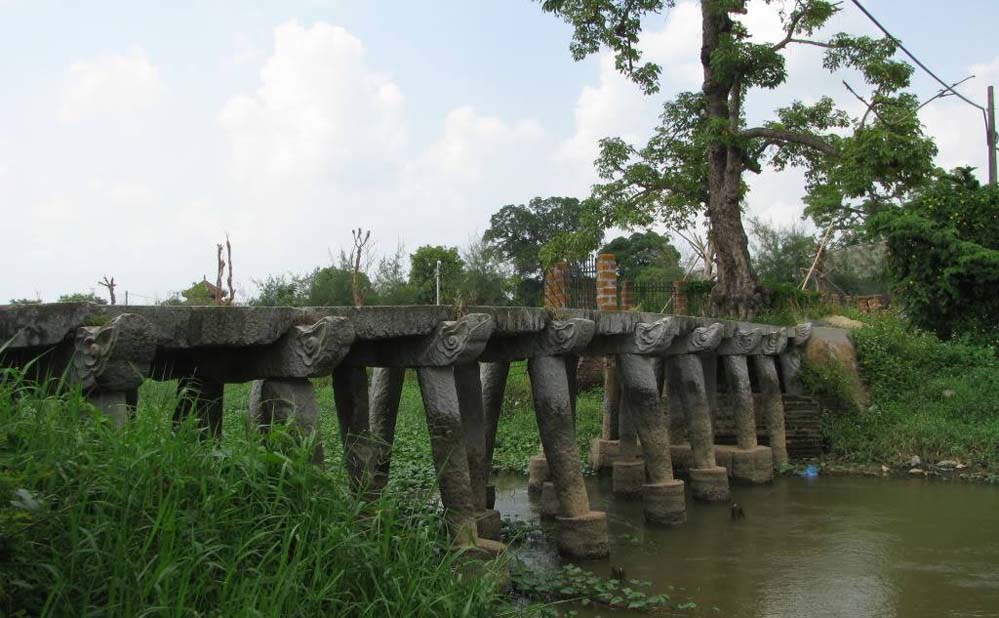Ancient stone bridge of Nom village

Coming to Nom village, visitors can immerse themselves in a complex of
ancient relics including the village gate, well, communal house yard, Nom
pagoda, Nom market, ancient houses and most uniquely, an extremely special
heritage - "Nom Bridge", from which to find a peaceful, rustic space imbued
with the ancient Northern countryside.
The stone bridge of Nom village is like a symbol of the people of Nom
village, almost all the folk songs and proverbs about the old Nom village
are symbolized by this bridge. Not only does it have unique historical,
cultural and architectural values, this over 200-year-old stone bridge is
considered by researchers to be a unique intact structure never seen in any
ancient village of the Red River Delta.
Following National Highway 5 from Hanoi to Hai Phong about 30 kilometers is
Nom village, located in Dai Dong commune, Van Lam district, Hung Yen
province. A prosperous ancient village with a unique complex of historical
and cultural relics that still retains the ancient features of a Vietnamese
village.
Located more than fifty kilometers from the once famous Pho Hien (Hung Yen
city), passing through new roads interspersed with red dusty dirt roads, you
can enjoy the intimate space of the ancient village that has been peacefully
lying here for hundreds of years. Coming to Nom village, visitors can
immerse themselves in a complex of ancient relics including the village
gate, well, communal house yard, Nom pagoda, Nom market, ancient houses and
most uniquely, an extremely special heritage - "Nom Bridge", from which to
find a peaceful, rustic space imbued with the character of an ancient
Northern countryside village.
Nom Bridge is a stone bridge across the Nguyet Duc River, a unique highlight
that brings special attraction to the pure Vietnamese cultural space of the
village. Not only does it have unique historical, cultural and architectural
values, the nearly 200-year-old ancient stone bridge of Nom village has been
evaluated by heritage researchers as a unique intact structure never seen in
any ancient village of the Red River Delta.
In the 16th century, this bridge was made of ironwood. To ensure the safety
and convenience of people traveling, during the reign of Tu Duc (1848-1883),
the bridge was completely replaced with stone. The bridge surface is nearly
2m wide, made of monolithic green stone, perfectly fitted together. The
large stone slabs were meticulously carved by artisans. Many researchers of
the village are amazed at the beauty and durability of this bridge.
The bridge is only over 1 meter wide but is still a place where villagers
travel every day. The bridge was built with 9 spans, according to the
ancients' concept, the number 9 symbolizes luck and fulfillment. The foot of
the bridge is made of cylindrical, uneven stone pillars roughly carved to
support the bridge beams. The bridge beams are rectangular. Although time
has made the bridge covered with moss and vines, the delicate ancient
patterns of the bridge are still easy to observe. Each bridge beam is
supported by three stone pillars. The stone outcrops of the bridge beams are
carved with quite sophisticated cloud patterns. This is a type of motif
often used to decorate ancient architecture, symbolizing good luck and
blessings. The bridge abutments were reinforced in 1942 with concrete.
The special feature in the construction of the Nom village stone bridge is
that the bridge deck, bridge girders and bridge legs only rest on each other
without any connecting materials such as mortar or screws like modern
bridges. However, after two centuries of existence, the bridge is still
stable. That shows that the design, material processing and bridge
construction skills of the ancient workers are very admirable. Today,
hundreds of people and vehicles still cross the bridge every day.
Crossing the 9-span bridge on the 200-year-old blue stone slabs over the
Nguyet Duc River, the road leads to Nom Market. Today's Nom Market no longer
has the image of the blacksmith under the banyan tree, the old lady chewing
betel next to the hand-woven baskets and trays. However, the yin-yang tiled
roofs, the market stalls under the slanted red brick walls still make us
feel like we are going back in time to decades ago.
The stone bridge not only connects the two banks to help people, it is not
only a traffic construction but also a unique highlight that brings special
attraction to the pure Vietnamese cultural space of Nom village. Crossing
the stone bridge, stepping into the ancient village to see all the
lifestyle, living habits, culture, and national soul of a simple countryside
in the Northern Delta...
Vietnam Impressive Travel
is one of the leading tour operators in Vietnam, providing high-quality
services, including Vietnam package tours, daily tours, car transport, and
visa procedures.





